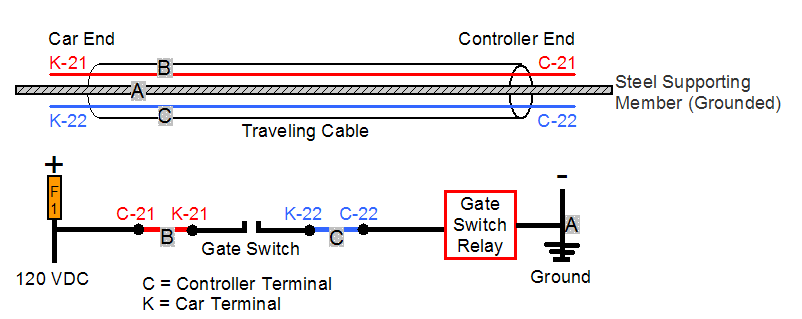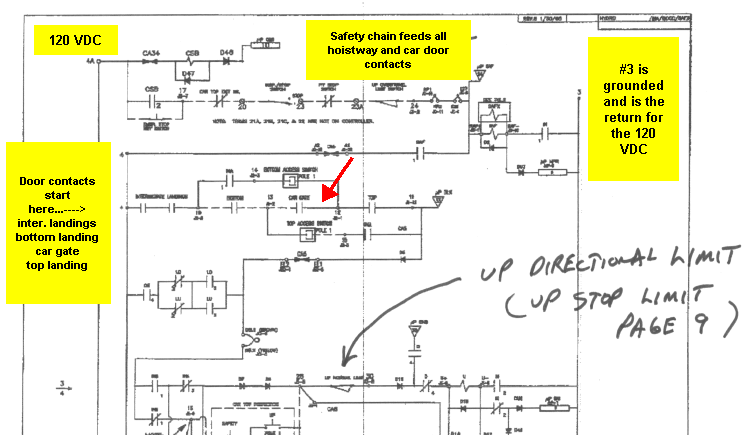

I could sense a bit of confusion about grounds and shorts so...I thought I would step in with a diagram. I am not trying to demonstrate how a traveling cable catches fire. I was hoping to clarify a few other things. The circuit I designed is not typical but it is plausible - I am only trying to make a point or two. I suspect that older elevators had circuits similar to this...but not as colorful.
The steel supporting member is required by the National Electrical Code 620.41 Suspension of Traveling Cables when the unsupported length of the traveling cable is greater than 60 m (200 ft). Typically this steel supporting member is grounded on both ends because of the way it is attached to the traveling cable support brackets. It is usually covered with a plastic like material that can wear out. In fact I know that during my career in the field I have had a few traveling cable conductors go to ground. I have also had a conductor or two go open on me and since the cable is flexing as the car moves up and down the hoistway it is sometimes hard to prove it is open but with a few clever troubleshooting techniques and an analog meter it can be proven...but I digress!
Remember, some traveling cables do not have a steel supporting member, because the rise is short and one is not required, but they always have a grounding conductor - the large conductor with green or green and yellow insulation - at least I have always found that to be the case.

If you look at the diagram above you will notice that there are only two conductors and the steel supporting member (SSM). Fuse F1 is a 5 ampere fuse. If the red wire (21) comes in contact with the SSM (B and A are touching) fuse F1 will more than likely open immediately - there is no resistance in the circuit so the fuse should perform the function it was designed for. This is a ground. If the blue wire (22) comes in contact with the SSM (C and A are touching) Fuse F1 will open as soon as the door lock contact is made (closes). This is also a ground. If B comes in contact with C the gate switch will always be "made up" because it is now jumped out. This is a short. Now, since the traveling cable is flexing every time the car moves, these conditions can come and go and raise hell with a normal person's outlook on life. (Not me, of course - "that hole in the machine room drywall was there when I got here!")
You can imagine that not all grounds are "solid" connections and neither are shorts always a good connection. If our imaginary grounded circuits above had 120 ohms of resistance to ground the current draw would be 1 amp and the fuse would not open but there would be heating and other bad things happening around the partial ground inside the traveling cable. Remember the wires are all tightly wound together inside the cable with little transfer of heat except for the outer surface of the traveling cable and the hoistway air.
I will now take a stab at a fire in the traveling cable. There is a process called "carbonization." Here is a description of this process in house wiring from a Google seach I performed. The site is called A Fun Zone and I know nothing about the author or the site but I have heard of this process before. About half-way down the page under "Electrical Installations and Appliances" it says, "Mains electrical wiring and their components can be a hidden source of heat that can cause a fire. Sometimes, due to loose contacts in the terminals of electrical switchboxes, some sparking will occur. If this is not found out early and rectified, the sparking will become worse, and the heat produced becomes more. Carbonization of the insulation materials will occur. Once the carbon gets deposited on the insulation materials, it becomes a conductor of electricity. Short-circuiting of the electrical wiring will occur leading to overheating of the wiring. If the electrical protection devices do not work, the overheating will cause the insulation materials of the wiring to even melt or decompose. When the decomposition gases given out by the insulation materials catch fire, the whole house can be burnt down." Now I know we are not talking about a house but I can visualize a traveling cable being affected in the same way.
![]()
![]()
![]()
![]()
![]()
A friend of mine from Holland asked me a question about the way hoistway door and car gate (door) contacts are wired in to the control system. Here is an example of one way it is done in the United States. This is a scan of a fax so it is not too clear but I think you can see what feeds what. The safety chain feeds all of the hoistway door and car door contacts. I think you might also see that if you had a short circuit in the traveling cable from a wire carrying 120 VDC to the wire that the red arrow is pointing to you would be bypassing all of the door contacts except the top door contact. ASME A17.1 Section 2.26.5 System to Monitor and Prevent Automatic Operation of the Elevator With Faulty Door Contact Circuits is designed to sense this abnormality and to take the car out of service. Hydraulic elevators must be equipped with this circuitry as well. (See 3.26.1)

What say you my fellow vertical transportation enthusiasts?

elevatorbob's Elevator Pictures